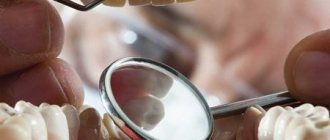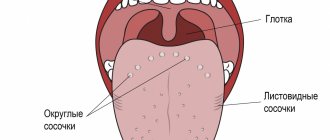The state of the tongue reflects the state of the human body. That is why almost any doctor during an examination asks the patient to show his tongue. In a healthy person, the tongue has a pale pink color, pronounced papillae, and a straight fold exactly in the center. It should be soft to the touch, and moving it should not cause discomfort or pain. If you find that you have a white tongue, then there is a high probability of certain problems in the body. In this article we will talk about how dangerous the appearance of plaque on the tongue is, what causes and diseases lead to changes in the condition of the organ, and how this problem can be avoided and eliminated.
Anatomy: what does the tongue consist of?
The tongue is an organ that is part of the digestive system. It performs several functions:
- plays an important role in the formation of speech;
- helps form a bolus of food in the mouth and push it into the esophagus;
- helps us determine the taste of food.
What does language consist of? The organ is conventionally divided into two parts:
- the body of the tongue is the anterior movable part;
- The root of the tongue is the back part located closer to the larynx.
The tongue has a mucous surface on which taste buds are located, thanks to which we distinguish different tastes.
What does plaque on the tongue mean?
At different periods of time, the appearance of the tongue may change, and a coating on the tongue that has a whitish color is acceptable in a small amount. At the same time, the papillae are clearly visible through it. In summer, the thickness of the plaque may increase, and in winter it may acquire a yellowish tint.
When should you worry about tongue coating?
- if the tongue is constantly coated;
- the plaque becomes dense and completely hides the mucous membrane;
- the papillae of the tongue are poorly visible;
- the color of the tongue has changed (excessive pallor, redness, blueness);
- the plaque has a dense cheesy structure;
- unusual color of plaque - yellow, green, brown, gray, black.
With such signs, we can talk about both dental pathologies and more serious problems - acute and chronic diseases of internal organs. To get rid of plaque on the tongue, you first need to find out the reason for its appearance.
The first step is a consultation with a dentist. Based on the results of the examination, the doctor will accurately determine whether the coated tongue is associated with caries, diseases of the oral cavity, and if not, he will refer you to other highly specialized specialists.
Forms of candidiasis in children
It is important to understand that candidiasis most often affects young children who cannot report a burning sensation or a change in taste, so special attention should be paid to changes in the child’s condition and consult a doctor in time. Symptoms depend on the form of the disease. More often in children, candidiasis is observed in the form of acute pseudomemranous stomatitis.
Mild form of candidiasis
Only one area is affected (for example, only the tongue or only the cheeks). Under the white coating there is a bright red mucous membrane without damage. The child's general condition does not suffer.
Moderate form of candidiasis
Various areas of the mouth are affected (eg, lips, cheeks, and tongue). The plaque is difficult to remove, and underneath there is damaged and even bleeding mucosa. Sometimes the lymph nodes are enlarged.
Severe form of candidiasis
The plaque is gray in color and covers not only the oral cavity, but also the tonsils and the back wall of the pharynx. The mucous membrane is dry, the plaque is almost impossible to remove, the lymph nodes are enlarged, the temperature rises, the child is weak and refuses to eat. This form may be accompanied by damage to the skin and genitals. Frequent relapses are characteristic.
Atrophic form of candidiasis
First, peeling of the epithelium occurs, then plaque films form, and the lesion looks like spots with a smooth surface. If the tongue is affected, then its papillae are smoothed out, and it becomes as if varnished, its movements are difficult, sensitivity and burning appear when eating.
Acute pseudomembranous candidiasis
The most common form of candidiasis, with this form a white coating is formed, which is often easily removed, exposing the bright red mucosa.
Erosive-ulcerative form of candidiasis
The mucous membrane is swollen, red, and after removing the plaque, erosions are found.
Hypertrophic candidiasis
Plaque forms in the form of plaques, is difficult to remove, saliva is viscous and foamy. When the tongue is affected, the papillae of the tongue become enlarged and turn black; this disease is called black hairy tongue.
Chronic candidiasis
The symptoms are not pronounced, it manifests itself from time to time with dryness, redness and plaque. If the tongue is affected, a burning sensation appears and swallowing is difficult. In children, chronic forms are rare and more often occur due to improper or incomplete treatment of acute candidiasis.
Why does plaque form on the tongue?
The most common and easily eliminated reason for the formation of white plaque on the tongue is poor oral hygiene.
However, there are other factors that influence the condition of the tongue. Among them:
- infectious diseases in the oral cavity (stomatitis, etc.);
- acute, chronic diseases and disorders of the gastrointestinal tract;
- respiratory diseases;
- infectious diseases;
- parasitic infection;
- candidiasis;
- kidney diseases.
Whether it is worth worrying about the health of certain organs can be judged by the color, nature and location of plaque on the tongue.
Differences by color
Many people know that by the color of the tongue one can understand that something is wrong with the body. It is not a myth that some diseases are reflected on the tongue by a characteristic shade of plaque.
Let's look at the most common ones:
- influenza accompanied by high body temperature - burgundy coating;
- heart problems, anemia, malnutrition – pale color;
- blood diseases and pathologies of the respiratory system - purple tint;
- gastrointestinal diseases, jaundice or smoking - gray or yellow color;
- problems with the liver or spleen, dysentery, advanced viral diseases, abscess - black plaque;
- kidney pathologies – bluish tint;
- circulatory disorders, heavy metal poisoning – blue color;
- fungal infection and general dehydration of the body - white plaque;
- dental diseases – whitish or dark brown color.
White coating on the tongue - what is it?
The main cause of plaque is poor hygiene and the resulting pathological conditions of the oral cavity. Therefore, first of all, you should see a dentist with such a problem.
In some cases, you can independently differentiate its causes by the color and location of the plaque. For example, why is the tongue white?
- 1
A white coating at the base of the tongue (in the root area) indicates high activity of bacteria or fungi. This may be due to both problems in the oral cavity and disturbances in the functioning of the intestines and other organs of the gastrointestinal tract. - 2
A thick white coating on the tongue is usually caused by an infection of the tonsils, respiratory tract or gastrointestinal tract.
- 3
A white, cheesy coating on the tongue is a sign of candidiasis (thrush).
- 4
A white coating on the tongue, as well as on the mucous tissues of the oral cavity, indicates stomatitis.
Dark tongue
Dark tongue
- This is a condition in which the papillae of the mucous membrane of the tongue become larger and acquire a dark brown or black color. The dark color of the tongue is given by waste products of microbes that inhabit the oral cavity and process iron found in food. In addition to changes in the size and color of the papillae, their qualitative change also occurs: they become stiffer.
The mouth of a healthy person is home to a wide variety of bacteria and microorganisms, both beneficial and pathogenic. If a person is healthy and has a strong immune system, these bacteria will not harm him. But if something goes wrong and the immune system is weakened, bacteria begin to actively multiply, and their life process is expressed in the form of a dense plaque on the teeth, tongue, and cheeks. A small coating is considered normal, there is no need to worry about this, but the tongue should be clearly visible.
If you notice that your tongue is dark in color, and the plaque itself is dense, sticky and quite difficult to remove, you should pay attention to your health. It is believed that the darker and denser it is, the more serious the disease and condition of the patient.
Yellow coating on the tongue
If your tongue turns slightly yellow in hot weather, there is no cause for concern. An alarming sign is the formation of a pronounced yellow coating on the tongue, which most often indicates serious disturbances in the functioning of the liver, gall bladder, and other pathologies of the digestive system.
Why is the tongue yellow?
- A small yellow plaque that appears in the morning and is easily removed during standard teeth brushing may indicate intoxication of the body (metabolic disorders, excess toxins). If the tongue remains clean for several hours after the procedure, then it really is a matter of toxins. To get rid of plaque, the patient needs to change his diet in order to normalize the functioning of the digestive system.
- Yellow plaque, loose in structure, combined with a specific taste and bad breath is a sign of serious disorders in the functioning of the gastrointestinal tract, requiring appropriate diagnosis and treatment. If such plaque appears, you need to contact a gastroenterologist.
- Yellow plaque in tandem with a high temperature may indicate inflammation of the ENT organs (pharyngitis, sore throat).
In addition, a yellow coating on the tongue inevitably appears in smokers, coffee and black tea drinkers.
How to clean your tongue
There are 3 ways - using a teaspoon, a scraper brush, or brushing with a soft toothbrush. You can even brush with a little or no paste, but don't just brush with paste without a brush, that's harmful. Cleaning your tongue morning and evening is just as important as brushing your teeth. Why? Because more germs always collect on the surface of your tongue than on all your teeth.
Scraper - its use is simple, easy and pleasant, it is plastic, does not damage the mucous membrane, is sold almost everywhere, in any pharmacy, requires changing every 6 months. There is always a teaspoon at hand, but it is less effective and convenient to use; it is better to wrap it in gauze. Recently, a special scraper-brush has been often used; it has a semicircular shape, soft bristles, is flat, and is quite effective. A soft toothbrush is often used.
Some people use improvised objects to clean their tongue, even their fingers: wrap three fingers in gauze and clean the tongue with massaging movements. Some people use sucking vegetable oil for 10-15 minutes and then spitting it into the toilet. At one time this method was very popular. The movements are longitudinal, from the root to the tip of the tongue, soft, massaging and slightly scraping; cleaning occurs sequentially, in zones, just like teeth.
There are special gels for the tongue; they are applied after brushing, kept in the mouth for 1-2 minutes, then rinsed thoroughly. Recently, in the USA and Europe, almost everyone has an irrigator - a miniturbine device that creates a jet pressure of liquid and perfectly cleans all interdental spaces, the space under dentures, the tongue, provides micro-hydromassage of the entire oral cavity, and is very easy to use. Cleaning your tongue cannot be neglected.
Black coating on the tongue
Black plaque looks especially scary; it can occur with long-term use of antibiotics and a number of other medications, and can also indicate a number of diseases:
- infectious disease, in particular cholera;
- Crohn's disease;
- acidosis – PH disturbance;
- viral sore throat.
A dark tongue may have a purple tint, which indicates blood diseases, including anemia. A plaque with a blue tint is one of the symptoms of dangerous diseases such as dysentery and typhoid.
Why does the coating on the tongue have spots?
In most cases, spots on the tongue have nothing to do with dangerous conditions and diseases. However, it is imperative to find out their cause and pay attention to eliminating the causative factors.
What types of spots exist and why do they appear:
- the tip of the tongue turns red and goes numb - most likely this happened as a result of injury (burn from hot, spicy food, smoking), and problems in the intestines and heart are also possible;
- bright pink spots on the tongue - depending on the size and location, they can be caused by a deficiency of vitamin B12, folic acid or the development of scarlet fever, migratory glossitis;
- bright red spots on a pale tongue are a symptom of scarlet fever, but also appear against the background of anemia, in smokers;
- red dots combined with a whitish coating at the root of the tongue most likely indicate diseases of the digestive system.
Types of stains
Spots on a child’s tongue can be different, both in shape and color. Depending on this, all the spots on the mucous membrane of the uvula can be divided into several groups.
Geographic language
In this case, the mucous membrane is very reminiscent of a map of countries and continents. This change can occur in children of all ages, including newborns. The tongue looks patchy and has areas of small bald patches that connect to each other. A similar type of mucous membrane is observed in the following pathologies:
- For diseases of a hormonal nature;
- With helminthic infestation;
- For diseases of the digestive system.
Geographic tongue spots can be of different shapes and sizes. In many cases, they are not a sign of a disease at all, and do not pose a danger to the child.
White spots
White spots on the mucous membrane are in most cases caused by fungi. Popularly, this pathology is called thrush. Candidiasis develops against the background of weakened immunity in children of different ages. Such spots have a cheesy appearance; they can cover not only the surface of the tongue, but also the cheeks and palate. When a fungal infection of the oral cavity occurs, the child cannot eat normally, he becomes moody and restless.
As first aid, the child’s oral cavity is treated with a soda solution. Prepare such a solution at the rate of 1 teaspoon of soda per glass of boiled water.
Red spots
Such spots almost always indicate an inflammatory or infectious disease of the oral cavity. The cause of red spots can be glossitis, stomatitis, herpes and bacterial dermatosis. The cause of this phenomenon may be an allergic reaction and consumption of red foods.
Quite often, the appearance of such spots is accompanied by pain and a burning sensation in the tongue. Due to pain, the child may refuse to eat and be capricious. Sometimes body temperature rises.
Depending on the cause, antifungal agents, antibiotics and antiviral drugs may be prescribed. It is recommended to treat areas of inflammation with antiseptic solutions such as Miramistin or Furacilin.
Dark spots
Often appear on the tongue after consuming certain foods. They are not dangerous and disappear after rinsing the mouth or brushing the tongue.
Black spots may appear as a result of prolonged treatment with antibacterial drugs. In this case, treatment comes down to normalizing the microflora of the digestive organs.
A very rare cause of dark spots are deep degenerative processes when areas of the mucous membrane die off. This condition requires urgent medical attention.
Yellow spots
Occurs when a child has problems with the digestive tract. Such spots densely cover the base of the tongue and the rest of its surface. Plaque consists of dead epithelium and is difficult to remove. This phenomenon is almost always accompanied by bad breath.
To eliminate the problem, you should undergo examination and treat diseases of the digestive tract. After treatment, the yellow plaque quickly disappears.
Blue spots
Blue spots on the tongue of children are extremely rare. They talk about problems with the cardiovascular system. To eliminate this phenomenon, sometimes it is simply necessary to normalize blood circulation in the vessels.
The cause of blue spots can be a hemangioma. In this case, there is most often one spot. Treatment in this case is always surgical.
Other spots
Normally, the tongue is covered with many taste buds, which give the mucous membrane a velvety appearance. With tongue injuries, burns and some inflammatory diseases, the taste buds die, forming smooth pink areas.
Such spots do not cause discomfort to the baby; his taste may only change slightly. This condition cannot be treated, since the taste buds are not restored.
When you see different spots on a child’s tongue, you should not panic, but you cannot ignore this phenomenon.
The baby should be shown to a doctor who will correctly diagnose and, if necessary, prescribe treatment. This article is for informational purposes only, please consult your doctor for details! Ask your doctor about contraindications and side effects.
How to remove plaque on the tongue?
- 1
Contact your dentist for advice. He will examine the oral cavity for dental diseases, carry out treatment if necessary (treatment of dental periodontitis, etc.), if plaque is associated with inflammatory processes in the oral cavity, and give recommendations on proper hygiene.
- 2
If the cause of the plaque is not related to dental health, the doctor will refer you to other specialists for examination.
What absolutely should not be done if plaque appears on the tongue:
- touch it with your hands;
- independently prescribe treatment for yourself, take medications without consulting a doctor;
- use solutions containing alcohol, iodine, hydrogen peroxide, brilliant green to clean the tongue;
- take vitamins without prior examination and doctor’s prescription.
In case of plaque or rashes on a child’s tongue, you need to be careful when planning your diet and do not introduce new foods, as they can provoke an allergic reaction and aggravate the situation.
How to get rid of plaque on the tongue?
- drink enough fluids, especially in hot, dry weather;
- to refuse from bad habits;
- introduce solid raw fruits and vegetables (apples, carrots) into the diet;
- take care of the health of the digestive system - adhere to a healthy diet, which will restore the intestinal flora, improve the functioning of the liver and pancreas, and normalize the acid-base balance;
- monitor the health of teeth and gums, undergo dental treatment on time;
- observe the rules of oral hygiene.
Treatment of spots, circles and dots on the tongue
When spots appear on a child’s tongue, consultation with a specialist is required, a full examination of the baby’s body, identification of the pathogen (if the disease is infectious), exclusion of dangerous pathologies: scarlet fever, neoplasms, as well as fungi and viruses. Therefore, all home therapy methods come down to alleviating symptoms:
- eliminating itching, burning and pain;
- temperature decrease above 38 °C;
- removing the initial plaque.
In this regard, antipyretic drugs, non-hormonal anti-inflammatory drugs and mild painkillers are good. If you suspect an allergic reaction, you need to give your baby antihistamines.
In addition to pharmaceutical products, before contacting a doctor, you can use a chamomile decoction (2 tsp per 200 ml of hot water) or a soda solution (2 tsp per 250 ml of water).
Conservative treatment depends on the diagnosis made by the doctor:
- Stomatitis. The therapeutic course consists of a diet, rinsing the mouth with herbal decoctions, local treatment of the mucous membrane with healing, antiseptic agents, and drugs aimed at eliminating the pathogen: antibacterial, antifungal, antiviral.
- Herpes. Treatment of the affected mucosa with antiviral gels, ointments, diet, taking medications to strengthen the immune system.
- Candidiasis. Treatment of fungal-affected areas of the oral mucosa with antifungal drugs (Candide), rubbing and rinsing with soda, taking medications to increase immunity.
If the cause of the appearance of plaque, red, whitish or other spots on the child’s tongue is an internal disease, it is necessary to direct all efforts to eliminate it.









